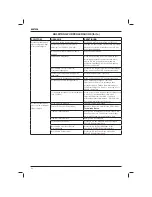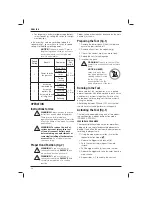
ENGLISH
49
f)
Keep cutting tools sharp and clean.
Properly maintained cutting tools with sharp
cutting edges are less likely to bind and are
easier to control.
g)
Use the power tool, accessories and
tool bits etc., in accordance with these
instructions taking into account the
working conditions and the work to
be performed.
Use of the power tool for
operations different from those intended
could result in a hazardous situation.
5) BATTERY TOOL USE AND CARE
a)
Recharge only with the charger
specified by the manufacturer.
A charger
that is suitable for one type of battery pack
may create a risk of fire when used with
another battery pack.
b)
Use power tools only with specifically
designated battery packs.
Use of any
other battery packs may create a risk of
injury and fire.
c)
When battery pack is not in use, keep it
away from other metal objects like paper
clips, coins, keys, nails, screws or other
small metal objects that can make a
connection from one terminal to another.
Shorting the battery terminals together may
cause burns or a fire.
d)
Under abusive conditions, liquid may
be ejected from the battery; avoid
contact. If contact accidentally occurs,
flush with water. If liquid contacts eyes,
additionally seek medical help.
Liquid
ejected from the battery may cause irritation
or burns.
6) SERVICE
a)
Have your power tool serviced by
a qualified repair person using only
identical replacement parts.
This will
ensure that the safety of the power tool is
maintained.
Safety Instructions for Cordless
Nailers
•
Always assume that the tool contains
fasteners.
Careless handling of the nailer can
result in unexpected firing of fasteners and
personal injury.
•
Do not point the tool towards yourself or
anyone nearby.
Unexpected triggering will
discharge the fastener causing an injury.
•
Do not actuate the tool unless the tool
is placed firmly against the workpiece.
If
the tool is not in contact with the workpiece,
the fastener may be deflected away from your
target.
•
Disconnect the tool from the power source
when the fastener jams in the tool.
While
removing a jammed fastener, the nailer may be
accidentally activated if it is plugged in.
•
Do not use this nailer for fastening
electrical cables.
It is not designed for electric
cable installation and may damage the insulation
of electric cables thereby causing electric shock
or fire hazards.
• Always wear safety glasses.
• Always wear ear protection.
• Only use fasteners of the type specified in the
manual.
• Do not use any stands for mounting the tool to
a support.
• Do not disassemble or block any parts of the
fastener driving tool such as the contact trip.
• Prior to each operation check that the safety
and triggering mechanism is functioning
properly and that all nuts and bolts are tight.
• Do not use the DCN690
–
when changing from one driving location
to another involving the use of scaffoldings,
stairs, ladders or ladder-like constructions,
e.g., roof laths, etc.;
– when closing boxes or crates;
–
when fitting transportation safety systems,
e.g., on vehicles, wagons, etc.
For exemptions check your local national
workplace regulations.
• Always check local workplace regulations.
• Do not use the tool as a hammer.
• Never actuate the fastener driving tool into free
space.
• In the work area, carry the tool at the workplace
using only one handle, and never with the
trigger actuated.
• Consider the conditions in the work area.
Fasteners can penetrate thin work pieces or slip
off corners and edges of the work piece, and
thus put people at risk.
• Do not drive fasteners close to the edge of the
workpiece.
• Do not drive fasteners on top of other fasteners.
Summary of Contents for DCN690
Page 1: ...DCN690 DCN691 DCN692 ...
Page 3: ...1 Figure 1 h g c m d i f g l c d b k j e f DCN692 DCN690 DCN692 n a ...
Page 4: ...2 Figure 3 Figure 2 Figure 2a g f q b o p l ...
Page 5: ...3 Figure 6 Figure 7 d j Figure 5 Figure 4 h r ...
Page 6: ...4 k aa bb gg ff hh ee cc cc dd ee aa Figure 8a Figure 8c Figure 8d Figure 8e Figure 8b bb ...
Page 278: ...276 ...
Page 279: ...277 ...
















































